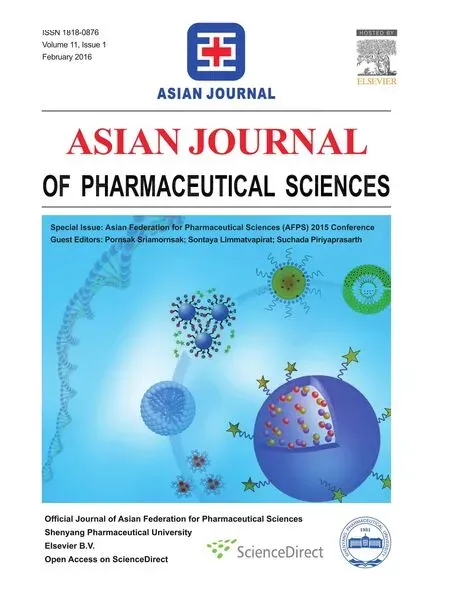In vitro wound-healing effects of biosynthesized copper nanoparticles
,Prteek Jin,Rghu Chndrshekhr Hrihrpur, Nynhirm Udup,Josyul Venkt Ro,
aDepartment of Pharmaceutical Biotechnology,Manipal College of Pharmaceutical Sciences,Manipal University,Manipal,Karnataka,India
bDirectorate of Research,Manipal University,Manipal,Karnataka,India
In vitro wound-healing effects of biosynthesized copper nanoparticles
Mradul Tiwaria,Prateek Jaina,Raghu Chandrashekhar Hariharpuraa, Nayanabhirama Udupab,Josyula Venkata Raoa,*
aDepartment of Pharmaceutical Biotechnology,Manipal College of Pharmaceutical Sciences,Manipal University,Manipal,Karnataka,India
bDirectorate of Research,Manipal University,Manipal,Karnataka,India
A R T I C L E I N F O
Article history:
Available online 25 November 2015
Biosynthesis
Copper nanoparticles
HaCat
Wound healing
Copper,the magical element,has been reported for centuries due to its signifcant role in the treatment of skin ailments. Copper is an essential element to our body and is known to possess antimicrobial,anti-infammatory and angiogenetic properties.Hence,it makes it useful in wound healing[1].In the present study we evaluated biosynthesized copper nanoparticles (BCuNps)for their wound-healing potential[2].The objective of this study was to evaluate wound-healing potential of BCuNps by in vitro studies.Antimicrobial activities of BCuNps and copper sulphate were compared against Escherichia coli,Bacillus subtilis Pseudomonas aeruginosa and Staphylococcus aureus by agar diffusion and broth dilution methods.HaCat(human skin keratinocytes)cells were used for assessment of woundhealing activity of BCuNps.The cells were cultured and maintained in DMEM and Ham F12 medium(1:1)supplemented with 10%foetal bovine serum.The CTC50(concentration of drug required to kill 50%of exposed cells)of BCuNps was determined by MTT assay.For further studies,concentrations below CTC50were used.Copper native(ion)was used as control during studies.BCuNps were evaluated for cell proliferation assay,evaluation of cell migration by scratch wound assay[3],and antiinfammatory effect by measuring the expression of COX-2.
BCuNps showed better antimicrobial effect and were found to be highly effective against Gram positive bacteria, viz.,B.subtilis(≤6.25 μg/ml>3.125 μg/ml)and S.aureus (≤50 μg/ml>25 μg/ml).The CTC50values of BCuNps were slightly higher,31 μg/ml,when compared to copper native(28 μg/ml). BCuNps enhanced the rate of cell proliferation as compared to copper native.BCuNps showed better cell migration in scratch wound assay and healed the wound within 24 hours.RT-PCR studies of COX2 expression showed that BCuNps exhibited better anti-infammatory activity than copper native.They suppressed the expression of COX-2 better than copper native at the same concentration.As compared to copper in its native form,BCuNps exhibited better wound healing activity.These BCuNps are innovative biopharmaceutical candidates.

Fig.1–Wound healing activity of BCuNps(A).Scratch wound assay for zero hour and 24 hour for BCuNps,copper sulphate and control.RT-PCR for COX-2 expression;Lane1–control cells;Lane 2–BCuNps;Lane 3–copper sulphate;Lane 4–ladder (B).
Acknowledgement
We wish to acknowledge the authorities of the Manipal College of Pharmaceutical Sciences,Manipal University,Department of Science andTechnology(DST)andAll India Council for Technical Education(AICTE)Government of India for providing the necessary facilities to carry out the research work.
R E F E R E N C E S
[1]Uriu-Adams JY,Keen CL.Copper,oxidative stress,and human health.Mol Aspects Med 2005;26(4):268–298.
[2]Tiwari M,Narayanan K,Thakar MB,et al.Biosynthesis and wound healing activity of copper nanoparticles.IET Nanobiotech 2014;8(4):230–237.
[3]Cory G.Scratch-wound assay.In:Cell migration.Springer; 2011.p.25–30.
*E-mail address:rao.josula@gmail.com,vr.josyula@manipal.edu.
Peer review under responsibility of Shenyang Pharmaceutical University.
http://dx.doi.org/10.1016/j.ajps.2015.11.070
1818-0876/?2016 Production and hosting by Elsevier B.V.on behalf of Shenyang Pharmaceutical University.This is an open access article under the CC BY-NC-ND license(http://creativecommons.org/licenses/by-nc-nd/4.0/).
 Asian Journal of Pharmacentical Sciences2016年1期
Asian Journal of Pharmacentical Sciences2016年1期
- Asian Journal of Pharmacentical Sciences的其它文章
- Determination of the antidepressant effect of mirtazapine augmented with caffeine using Swiss-albino mice
- Photosafety testing of dermally-applied chemicals based on photochemical and cassette-dosing pharmacokinetic data
- Biopharmaceutics classifcation system(BCS)-based biowaiver for immediate release solid oral dosage forms of moxifoxacin hydrochloride (Moxifox GPO)manufactured by the Government Pharmaceutical Organization(GPO)
- Bioequivalence study of abacavir/lamivudine (600/300-mg)tablets in healthy Thai volunteers under fasting conditions
- Evaluation of cytotoxic and infammatory properties of clove oil microemulsion in mice
- Analytical method development of pregabalin and related substances in extended release tablets containing polyethylene oxide
